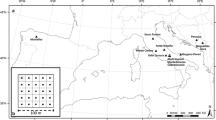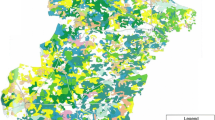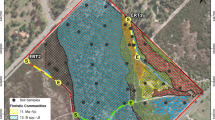Abstract
Soil variability was assessed in a 74.2-ha area within the Žofínský prales natural forest. Parameters evaluated for 1765 soil profiles inside 353 graticule plots were as follows: (1) thickness of organic horizons, (2) thickness and form of mineral horizons, (3) humus form (HF), (4) soil taxonomic unit (STU) and (5) anomalies. In addition, soil reaction (pHKCl) and oxidizable carbon content (Cox) were measured in the laboratory for 734 samples from the upper mineral (A) and lower mineral (B) horizons. The most frequently occurring humus form was mor followed by moder, hydromor and peaty T-horizon. Entic Podzols, Dystric Cambisols, Haplic Cambisols, Albic Podzols, Histic (or Haplic) Gleysols, Endogleyic Stagnosols, Fibric or Hemic or Sapric Histosols and Stagnic Gleysols were all present at the site despite its homogeneous geological bedrock. Overall coefficient of variance (CV) was lower in terrestrial soils compared with (semi-)hydromorphic soils. Overall variance decreased in both soil groups with increasing depth, as did CV differences between the fine (up to 10 m) and the locality scales. The lowest CV values occurred for Cox and pHKCl. The CV values differed between STUs as well. Compared to lower horizons, variograms of upper horizons showed greater autocorrelation at the intermediate spatial scale (10–320 m)—ranging from 50 to 150 m. Semivariance values, however, reached 70–80% of sill already at a distance of 10 m. The most significant factor of variability at all studied spatial scales is presumably the soil disturbance regime, followed by terrain micro-topography and the effect of tree species.







Similar content being viewed by others
References
Agbu PA, Olson KR (1990) Spatial variability of soil properties in selected Illinois Mollisols. Soil Sci 150:777–786
Alexandrovskiy AL (2007) Rates of soil-forming processes in three main models of pedogenesis. Revista Mexicana Ciencias Geológicas 24:283–292
Anderson RS (2002) Modeling the tor-dotted crests, bedrock edges, and parabolic profiles of high alpine surfaces of the Wind River range, Wyoming. Geomorphology 46:35–58
Anonymous (1995) ISOIDIS 14235. Soil quality. Determination of organic carbon in soil by sulfochromic oxidation. International Organization for Standardization, Berlin
Baniamino F, Ponge JF, Arpin P (1991) Soil acidification under the crown of oak trees I. spatial distribution. Forest Ecol Manag 40:221–232
Bens O, Buczko U, Sieber S, Hüttl RF (2006) Spatial variability of O layer thickness and humus forms under different pine beech–forest transformation stages in NE Germany. J Plant Nutr Soil Sci 169:5–15
Bormann BT, Spaltenstein H, McCleellan MH, Ugolini FC, Cromack K Jr, Nay SM (1995) Rapid soil development after windthrow disturbance in pristine forests. J Ecol 83:747–757
Borůvka L, Mládková L, Penížek V, Drábek O, Vašát R (2007) Forest soil acidification assessment using principal component analysis and geostatistics. Geoderma 140:374–382
Boublík K, Lepší M, Lepší P (2009) Vegetation of the Žofínský Prales nature reserve (Novohradské Hory Mts., Czech Republic). Silva Gabreta 15:121–142 (in Czech)
Braun-Blanquet J (1921) Prinzipien einer Systematik der Pflanzengesellschaften auf floristischer Grundlage. St. Gallen, Jahrbuch der St. Gallischen, Naturwissenschaftlichen Gesellschaft 57:305–351
Bringmark E, Bringmark L (1998) Improved soil monitoring by use of spatial patterns. Ambio 27:45–52
Buol SW, Southard RJ, Graham RC, McDaniel PA (2003) Soil genesis and classification, 5th edn. Iowa State Press, Ames
Clément P (1993) Erosion balance and slope evolution under continental humid temperature climate: an Appalachian example (Quebec, Canada). Catena 20:303–315
Collins BS, Pickett STA (1982) Vegetation composition and relation to environment in an Allegheny hardwoods forest. Am Midl Nat 108:117–123
Cools N, Mikkelsen JH, De Vos B (2007) Evaluation of the key to the European Humus Classification System, Terrestrial humus forms. Inbo—Instituut voor natuur- en bosonderzoek. 3rd meeting of the European Humus Research Group, 20–23 June 2007. Cagliari, Sardegna
Cox MS, Gerard PD, Abshire MJ (2006) Selected soil properties’ variability and their relationships with yield in three Mississippi fields. Soil Sci 171:541–551
Cressie N, Wikle CK (1998) The variance-based cross-variogram: you can add apples and oranges. Math Geol 30:789–799
D’Amoto A, Orwig DA (2008) Stand and landscape-level disturbance dynamics in old-growth forests in western Massachusetts. Ecol Monogr 78:507–522
Driessen P, Deckers J, Spaargaren O, Nachtergaele F (2001) Lecture notes on the major soils of the world. World Soil Resour Reports 94:1–334
Ellenberg H (1996) Vegetation Mitteleuropas mit den Alpen in ökologischer, dynamischer und historischer Sicht. Verlag Eugen Ulmer, Stuttgart
Fraver S, White AS, Seymour RS (2009) Natural disturbance in an old-growth landscape of northern Maine, USA. J Ecol 97:289–298
Frelich LE, Lorimer CG (1991) Natural disturbance regimes in hemlock hardwood forests of the upper Great-Lakes Region. Ecol Monogr 61:145–164
Gallardo A, Paramá R (2007) Spatial variability of soil elements in two plant communities of NW Spain. Geoderma 139:199–208
Garten CT Jr, Kang S, Brice DJ, Schadt CW, Zhou J (2007) Variability in soil properties at different spatial scales (1 m–1 km) in a deciduous forest ecosystem. Soil Biol Biochem 39:2621–2627
Gömöryová E, Gregor J, Pichler V, Gömöry D (2006) Spatial patterns of soil microbial characteristics and soil moisture in a natural beech forest. Biologia 61:329–333
Gruba P (2009) The influence of trees on spatial variability of pH in top horizons of forest soil. Sylwan 153:330–335
Grundmann GL, Debouzie D (2000) Geostatistical analysis of the distribution of NH4+-and NO2-oxidizing bacteria and serotypes at the millimeter scale along a soil transect. Microb Ecol 34:57–62
Guo D, Mou P, Jones RH, Mitchell RJ (2002) Temporal changes in spatial patterns of soil moisture following disturbance: an experimental approach. J Ecol 90:338–347
Guo D, Mou P, Jones RH, Mitchell RJ (2004) Spatio-temporal patterns of soil available nutrients following experimental disturbance in a pine forest. Oecologia 138:613–621
Hruška J, Cienciala E (eds) (2003) Long-term acidification and nutrient degradation of forest soils–limiting factors of forestry today. Czech Ministry of Environment, Praha
Isaaks EH, Srivastava RM (1989) Applied geostatistics. Oxford University Press, New York
Kabrick JM, Clayton MK, McBratney AB, McSweeney K (1997) Cradle-knoll patterns and characteristics on drumlins in northeastern Wisconsin. Soil Sci Soc Am J 61:595–603
Klinka K, Fans J, Krestov P (1997) Towards a taxonomic classification of humus forms; third approximation. Scientia Silvica, Extension Series No. 9. Forestry Sciences Department. The University of British Columbia, Vancouver
Korpel S (1995) Die Urwälder der Westkarpaten. Gustav Fischer, Stuttgart
Král K, Janík D, Vrška T, Adam D, Hort L, Unar P, Šamonil P (2010a) Local variability of stand structural features in beech dominated natural forests of Central Europe: Implications for sampling. For Ecol Manag 260:2196–2203
Král K, Vrška T, Hort L, Adam D, Šamonil P (2010b) Developmental phases in a temperate natural spruce-fir-beech forest: determination by a supervised classification method. Eur J Forest Res 129:339–351
Legendre P (1993) Spatial autocorrelation: trouble or new paradigm? Ecology 74:1659–1673
Lin H, Wheeler D, Bell J, Wilding L (2005) Assessment of soil spatial variability at multiple scales. Ecol Model 182:271–290
Manzoni S, Porporato A (2009) Soil carbon and nitrogen mineralization: theory models across scales. Soil Biol Biochem 41:1355–1379
Martin WKE, Timmer VR (2006) Capturing spatial variability of soil and litter properties in a forest stand by landform segmentation procedures. Geoderma 132:169–181
Mayer H (1989) Windthrow. Philos Trans R Soc Lond B324:267–281
Michéli E, Schad P, Spaargaren O, Dent D, Nachtergale F (2006) World Reference Base for Soil Resources 2006. World Soil Resources Reports 103. Food and Agricultural Organization of the United Nations, Rome
Muukkonen P, Hakkinen M, Makipaa R (2009) Spatial variation in soil carbon in the organic layer of managed boreal forest soil-implications for sampling design. Environ Monit Assess 158:67–76
Němeček J, Macků J, Vokoun J, Vavříček D, Novák P (2001) Taxonomický klasifikační systém půd České republiky. Praha, ČZU, VÚMOP
Okae-Anti D, Ogoe JI (2006) Analysis of variability of some properties of a semideciduous forest soil. Commun Soil Sci Plan 37:211–223
Outeiro L, Asperó F, Úbeda X (2008) Geostatistical methods to study spatial variability of soil cations after a prescribed fire and rainfall. Catena 74:310–320
Oyama M, Takehara H (2001) Revised standard soil color charts. Ejkelklamp Agrisearch Equipment, Tokyo
Peigné J, Vian J-F, Cannavacciuolo M, Bottollier B, Chaussod R (2009) Soil sampling based on field spatial variability of soil microbial indicators. Eur J Soil Biol 45:488–495
Phillips JD (2001) Divergent evolution and the spatial structure of soil landscape variability. Catena 43:101–113
Phillips JD (2008) Soil system modelling and generation of field hypotheses. Geoderma 145:419–425
Phillips JD, Marion DA (2004) Pedological memory in forest soil development. Forest Ecol Manag 188:363–380
Phillips JD, Marion DA (2006) Biomechanical effects of trees on soil and regolith: beyond treethrow. Ann Assoc Geogr 96:233–247
Phillips JD, Gosweiler J, Tollinger MA, Gordon R, Mayeux S, Witmeyer M, Altieri T (1994) Edge effects and spatial variability in coastal plain Ultisols. Southeast Geogr 34:125–137
Phillips JD, Marion DA, Luckow K, Adams KR (2005) Nonequilibrium Regolith thickness in the Ouachita mountains. J Geol 113:325–340
Průša E (1985) Die böhmischen und mährischen Urwälder - ihre Struktur und Ökologie, Vegetace ČSSR A15. Academia, Praha
Qian H, Klinka K (1995) Spatial variability of humus forms in some coastal forest ecosystems of British Columbia. Ann For Sci 52:653–666
Riha SJ, Senesac G, Pallant E (1986) Effects of forest vegetation on spatial variability of surface mineral soil pH, soluble aluminium and carbon. Water Air Soil Poll 31:929–940
Šamonil P, Vrška T (2007) Trends and cyclical changes in natural fir-beech forests at the North-western edge of the Carpathians. Folia Geobot 42:337–361
Šamonil P, Král K, Douda J, Šebková B (2008a) Variability in forest floor at different spatial scales in a natural forest in the Carpathians: effect of windthrows and mesorelief. Can J For Res 38:2596–2606
Šamonil P, Šebková B, Douda J, Vrška T (2008b) Role of position within the windthrow in forest floor chemistry in the flysch zone of the Carpathians. Can J For Res 38:1646–1660
Šamonil P, Antolík L, Svoboda M, Adam D (2009) Dynamics of windthrow events in a natural fir–beech forest in the Carpathian mountains. Forest Ecol Manag 257:1148–1156
Šamonil P, Král K, Hort L (2010a) The role of tree uprooting in soil formation: a critical literature review. Geoderma 157:65–79
Šamonil P, Tejnecký V, Borůvka L, Šebková B, Janík D, Šebek O (2010b) The role of tree uprooting in Cambisol development. Geoderma 159:83–98
Schaetzl RI, Burns SF, Johnson DL, Small TW (1989) Tree uprooting: review of impacts on forest ecology. Vegetatio 79:165–176
Schöning I, Totsche KU, Kögel-Knabner I (2006) Small scale spatial variability of organic carbon stocks in litter and solum of a forested Luvisol. Geoderma 136:631–642
Seastedt TR, Adams GA (2001) Effects of mobile tree islands on alpine tundra soils. Ecology 82:8–17
Shukla MK, Slater BK, Lal R, Cepuder P (2004) Spatial variability of soil properties and potential management classification of a chernozemic field in lower Austria. Soil Sci 169:852–860
Skvorcova EB, Ulanova NG, Basevic VF (1983) Ekologiceskaja rol vetrovalov. Lesnaja Promyslennost, Moskva
Small EE, Anderson RR, Hancock GS (1999) Estimates of the rate of regolith production using 10Be and 26Al from an alpine hillslope. Geomorphology 27:137–150
Stork R, Dilly O (1998) Scale-dependent spatial variability of microbiological characteristics in soil of a beech forest. Zietschrift fur pflanzenernahrung und bodenkunde 161:235–242
Trangmar BB, Yost RS, Uehara G (1985) Application of geostatistics to spatial studies of soil properties. Adv Agron 38:45–94
Ulanova NG (2000) The effects of windthrow on forests at different spatial scales: a review. Forest Ecol Manag 135:155–167
Unar P (2009) Changes in the vegetation of the Žofínský Prales nature reserve in the period 1975–2008. Silva Gabreta 15:155–172
Welzholz JC, Johann E (2007) History of Protected Forest Areas in Europe. In: Frank G, Parviainen J, Vandekerkhove K, Latrham J, Schuck A, Little D (eds) Protected forest areas in Europe–analysis and harmonisation (PROFOR): Results, conclusions and recommendations. Federal Research and Training Centre for Forests, Natural Hazards and Landscape, Vienna, pp 17–40
Yavitt JB, Harms KE, Garcia MN, Wright SJ, He F, Mirabello MJ (2009) Spatial heterogeneity of soil chemical properties in a lowland tropical moist forest, Panama. Aust J Soil Res 47:674–687
Zar JH (1996) Biostatistical analysis, 3rd edn. Prentice-Hall, Upper Saddle River
Acknowledgments
The authors would like to thank their colleagues from the “Blue Cat research team” for field data measurement—Dušan Adam, Petra Doleželová, Libor Hort, David Janik, Kamil Král, Hana Kučeráková, Pavel Unar. The authors would also like to thank all anonymous reviewers, as their comments and suggestions considerably improved the quality of the paper. The research was supported by the Czech Science Foundation (project No. 526/09/P335), the Czech Ministry of the Environment (project No. MSM 6293359101) and by the Mendel University in Brno (project no. IGA 12/2009).
Author information
Authors and Affiliations
Corresponding author
Additional information
Communicated by A. Merino.
Appendices
Appendix 1
See Fig. 8.
Appendix 2
See Fig. 9.
Presence of individual soil taxonomical units (STU) in sample plots. Size of circles indicates the number of cases of evaluated STU within a plot (0–5 cases). a—presence of hydromorphic and semihydromorphic STUs (“wet sites”), upper left picture shows water impact within individual plots (percentage of surface); b—presence of terrestrial STUs (“dry sites”)
Appendix 3
See Fig. 10.
Appendix 4
See Fig. 11.
Rights and permissions
About this article
Cite this article
Šamonil, P., Valtera, M., Bek, S. et al. Soil variability through spatial scales in a permanently disturbed natural spruce-fir-beech forest. Eur J Forest Res 130, 1075–1091 (2011). https://doi.org/10.1007/s10342-011-0496-2
Received:
Revised:
Accepted:
Published:
Issue Date:
DOI: https://doi.org/10.1007/s10342-011-0496-2








